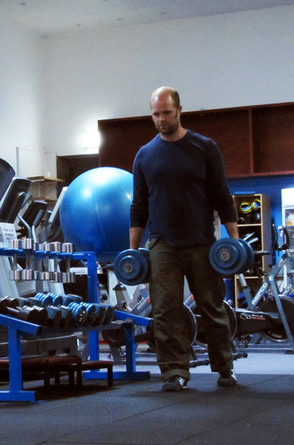 The farmer's walk Okay, when you’re tackling an exercise like chin-ups, it’s easy to get intimidated. There’s a balance between doing enough ‘assistance’ work and too much. If you only train the individual components such as elbow flexion and grip strength, and neglect taking your body through the whole general movement, it’s hard to progress. Likewise if you just try to muscle them out without thinking about breaking them down, it’s also hard to progress. Come to think of it, they’re chin-ups. Progression is always going to be hard. But if you break it down well, you can work out an effective training process, one that works for you. In the last post I did on chin-ups, I took a look at the general movement, with varying degrees of assistance from the legs. So you didn’t have your entire body-weight hanging from the bar. In this post I’m going to talk about grip strength and how to develop it. Clearly, if you’re going to be able to do chin-ups, you’ll need to be able to hang from a bar. This can be a lot more difficult than is sometimes suspected. Considering that we’d like to build up to multiple repetitions of the chin-up, being able to hang from a bar with a straight body (a dead hang) for 45 to 60 seconds is a good goal to shoot for. 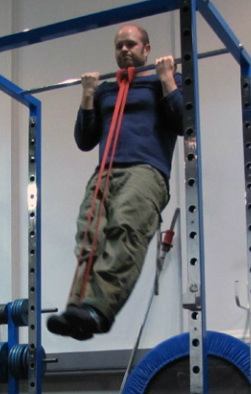 Holding the chin-up If you find it particularly difficult to hang, try holding onto the bar with a ‘mixed grip’, which means one hand is facing towards you, while the other hand is facing away. Squeeze the bar and really try to pull it in against the heel of your palm – rather than just holding on by the fingertips. If you can’t pull the bar into your palm, and you are only holding on by your fingertips, you’re not strong enough for this exercise yet. You might find it easier to hold the chin-up position at the top, rather than the bottom (as pictured, using a resistance band for assistance). Don’t think of pulling your chin up, that might just tighten you up through the shoulders. Think instead of pulling your elbows down to your hips, that will help to keep your shoulders down away from your ears. If you can hold this position without assistance for 20 to 30 seconds, you’re doing exceptionally well. If all of the above is too intense, try a farmer’s walk instead. Pick up two heavy dumbbells – one in each hand – and go for a 30 second walk around the gym. You’re not doing anything with the dumbbells, except for holding on to them tightly. Because of the dynamics of momentum, each time you take a step the dumbbells will feel heavier. Step as gently and as slowly as you’d like. Bear in mind that if you weigh 80 kilograms, you’ll ideally want to build up to doing a farmers walk with at least 40 kilograms in each hand, preferably 50 or more. If you can hang on to more than your own bodyweight, it’ll put you in a very good position when it comes to chin-ups. Even if you can hang from a bar for 60 seconds or more, the farmer’s walk is still a valuable exercise for developing your grip strength. 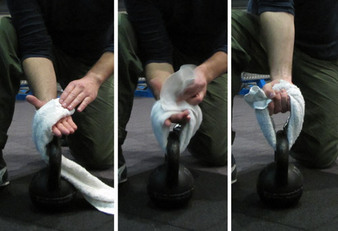 Wrapping a towel through a kettlebell As a general rule of thumb, anything you can maintain for more than 20 seconds or so isn’t doing much to increase your strength. It will help your endurance, but physiologically there’s a difference between strength in terms of explosive power, and strength in terms of short-term endurance like how many push-ups you can do in a row. This is why squeezing a stress ball for 45 seconds doesn’t make you much stronger. In time you might be able to do it for longer, but in terms of your maximum bar-crushing grip strength, it won’t really help that much. You need to increase the intensity. Doing something for longer is not the same as doing the same thing more intensely. Both are important, and if you want to improve at any body-weight exercise like chin-ups or push-ups, you can’t really afford to neglect either the development of power or training your endurance. 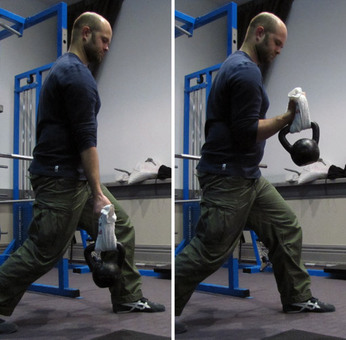 The kettlebell towel curl So it’s good to play around with loading parameters. Try going for a 60 second farmer’s walk holding relatively light dumbbells, and also try just picking up some really heavy weights and holding them for five to ten seconds, before putting them straight back down again. Repeat that a few times if you like. Varying the load will help to stimulate the muscles for both power and endurance. One of my favourite grip/arm exercises are towel curls and extensions with a kettlebell. Kettlebells are convenient, but of course you can use any heavy object that you can thread a towel through, or – and this can be even better – a heavy bag with thick handles. Towels or some sort of fabric train your finger and hand muscles much better than a solid bar ever will. 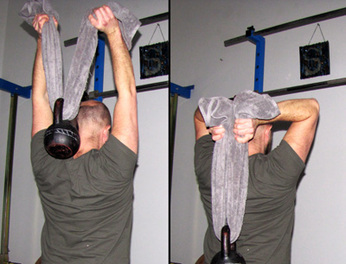 The kettlebell towel extension The curls are relatively simple – flex the wrist first and then the elbow immediately after to lift the weight forwards and up. The extensions are a bit more tricky – you have to be careful not to hit yourself in the back of the head, and getting in and out of the position can be a little challenging too. Direct arm training is an interesting topic in relation to chin-ups and power. It’s easy to over- or under-train. Too much and you’ll be fatigued all the time, too little and you won’t manage to strengthen your weak points. I’m currently spending almost none of my training time on curls and extensions, because I find working on the actual chin-up five or six days per week is helping me to progress well, and if I add in direct arm training I fatigue too much. 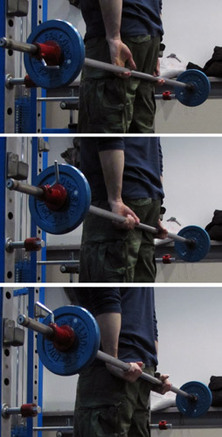 Barbell wrist curl Possibly my all-time favourite grip and forearm flexion exercise is the behind-the-back forearm curl. It’s as simple as it looks. Start holding the barbell with your fingertips, then in one smooth motion, pull the bar into the base of the hand and use that momentum to complete the wrist curl at the top. The main reason to hold the bar behind your back is so that you can’t bend the elbows. This isolates the forearms nicely. I like to train this exercise in a range of 5 to 10 repetitions, which is a little heavier than I’ll usually train biceps curls or triceps extensions. Finally, there’s the wrist-roller. This is excellent – but they’re hard to find so you may need to make one. Basically you’re walking your hands one at a time, so that you unroll or roll up the rope which has a weight attached to the end. If it’s very heavy, there’s a tendency to only take very small steps with your hands. But if you want to work the muscles through a large range of motion with this exercise – and I think it’s good to do so – you want to take large, controlled steps, flexing and extending your wrists fully. Don’t rush this one, take your time. It’s good for endurance and bar-control. When it comes to structuring your training, if you use the basic chin-up/squat/stand technique that I outlined in my previous post on chin-ups, that can remain the primary focus of your training. Do as many reps or sets as seems appropriate to you. Then you can choose some or all of the above exercises, depending on what you find rewarding and what you think might help you develop. Keep in mind that these are assistance exercises, and by themselves they won’t magically make you any more awesome than you already are, but they can help you to bring up your weak points. 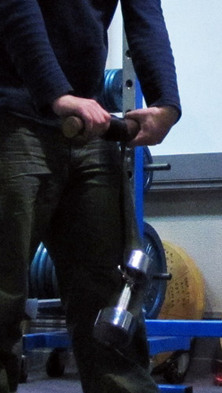 The wrist-roller As such, a few sets of a couple of these exercises should be enough to help you develop. You could start your workout with some sort of shoulder warm-up – whatever feels appropriate to prepare you and prime your shoulders for the work ahead. The main focus of your session could be two to five sets of the chin-up/squat exercise, then a few short, heavy farmer’s walks, followed by a set of kettlebell towel extensions and a set of barbell wrist curls and maybe finish off with a lighter, longer farmer’s walk or a bit of a hang from a bar, with your feet gently resting on the ground if need be. Choose whatever exercises you like, and play around with how you organise them. You don’t need to pick the same ones every time you train, you just need to be challenging yourself to develop. Rest as much as you like in between each set. It’s strength training, not calorie burning, so recovery time is important. Go again when you’re ready, and only when you think you’re capable of working strongly and completing a satisfying set. If you were to train in this way it might take you 15 to 25 minutes to complete your session, which is time well spent. If you train for much longer than that it might only fatigue you excessively, and if you spend much less time than that you mightn’t get enough work done to provide a good strength stimulus. Remember that you grow stronger in between your training sessions when you’re recovering, so sleep enough, eat enough, and train enough – whatever all that means for you. Find out by experimenting, with awareness and curiosity. As usual, let me know how you’re going...
0 Comments
Leave a Reply. |
